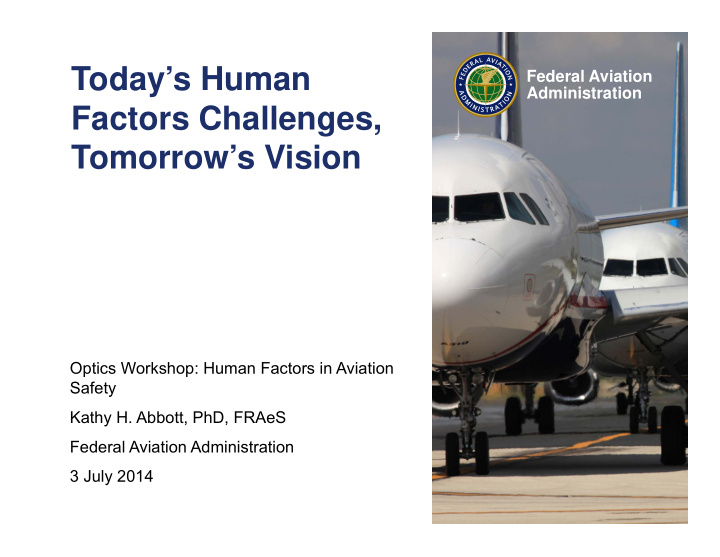



Today’s Human Federal Aviation Administration Factors Challenges, Tomorrow’s Vision Optics Workshop: Human Factors in Aviation Safety Kathy H. Abbott, PhD, FRAeS Federal Aviation Administration 3 July 2014
Flightpath 2050 • Societal and market needs • Industrial leadership • Environment and energy • Safety and security • Prioritizing research Federal Aviation 2 Administration
Characteristics of Civil Aviation • Dynamic • Complex • Market driven • Rapidly changing technology • Changes in expectations of safety Federal Aviation Administration
Challenges for Aviation Safety • Societal expectations for safety • One size does not fit all Federal Aviation 4 Administration
U.S. Aviation Fatal Accident Rates Annual Average from 2005 through 2009 Scheduled part 121 Corporate Scheduled part 135 On demand part 135 Business Personal LSA Amateur-built 0 1 2 3 4 5 6 7 8 Fatal Accidents per 100,000 Flight Hours Federal Aviation 5 Administration
Society’s Safety Expectations – Circa 1945 Lockheed Constellation 1943 PHOTO: Public Domain Commercial Douglas DC-6 1947 PHOTO: Everts Air Cargo Cessna 195 1947 PHOTO: Bidgee General Cessna 140 Aviation 1946 PHOTO: Tom Gideon Less More Public Demand for Safety Assurance Demand Demand Federal Aviation Administration
Society’s Safety Expectations – Circa 1945 Lockheed Constellation 1943 PHOTO: Public Domain Commercial Douglas DC-6 1947 PHOTO: Everts Air Cargo Societally Accepted Risk Zero Risk (1940s) No Operations Cessna 195 1947 PHOTO: Bidgee General Cessna 140 Aviation 1946 PHOTO: Tom Gideon Absolute Safety Less More Public Demand for Safety Assurance Demand Demand Federal Aviation Administration
Society’s Safety Expectations – Today Continuously Advancing… (2014) More Less Public Demand for Safety Assurance Demand Demand Federal Aviation Administration
Society’s Safety Expectations – 2018 Continuously Advancing… More Less Public Demand for Safety Assurance Demand Demand Federal Aviation Administration
Applying the Safety Continuum System Safety + Risk of accidents due to inadequate Total Risk safety program Risk of accidents due to lack of safety innovation - Figure Adapted from Figure 3-1 of FAA System Safety Handbook http://www.faa.gov/library/manuals/aviation/risk_management/ss_handbook/ Extent of Safety Effort Federal Aviation Administration
Applying the Safety Continuum System Safety + Too little rigor… Too much rigor… SEEK Establish appropriate → safety escapes → innovative safety balance in our regulatory enhancements don’t reach the → fatal accidents increase approach fleet Achieve safety → Finite dollars that could be objectives while spent on safety enhancements imposing the least go elsewhere burden on society. → fatal accidents increase Risk of accidents due to inadequate Total Risk safety program Risk of accidents due to lack of safety innovation - Extent of Safety Effort Federal Aviation Administration
Challenges for Aviation Safety • Societal expectations for safety • One size does not fit all • Increasing amounts and types of operational data • Pressures: economic, security, environmental • Changing workforce demographics • Changes in technology and operations • Where to put risk mitigation Federal Aviation 12 Administration
New Technologies and Operations Federal Aviation 13 Administration
Fatal accident rate per million departure 0 1 2 3 4 5 6 7 1959 Cumulative Fatal accident rate, end 2013 1960 1961 Courtesy Airbus 1962 1963 1964 1965 1966 1967 1968 1969 Early jet 1st generation: 1970 1971 1972 1973 1974 1975 1976 1977 1978 1979 1980 2 nd jet generation 2nd generation: 1981 1982 1983 1984 1985 1986 1987 1988 1989 1990 1991 1992 FMS Nav display Glass-cockpit 3rd generation: 1993 1994 1995 1996 1997 1998 Administration Federal Aviation 1999 2000 2001 2002 2003 2004 2005 Protection Flight Envelope FBW 4th generation: 2006 2007 2008 2009 2010 2011 2012 2013
Federal Aviation Administration
Where to put risk mitigation Flexibility/ Adaptability Design Pilot TCAS/ Envelope Flight Protection ACAS Engineer Director Cat III Circling Autoland Approaches Pilot Error Designer Error
…But the biggest challenge to aviation safety is Complacency Federal Aviation 17 Administration
Challenges for Aviation Human Factors • Increase in knowledge and skills needed • HF is much more than research • HF workforce – where will we get them? • Integrating HF into every aspect of aviation • Changing operator roles • Automation/autonomy Federal Aviation 18 Administration
Scope of Operation / Interrelationships - Pilot Knowledge and Skills Needed Advanced Advanced Normal Basic/ Contingency Normal Normal Crew Coordination, Problem Solving, and Manual Handling Skills 1960s 2000s Timeframe Federal Aviation Administration
Higher System Performance Achieved by Altering Operator Role Change in Role Potential Result • Demanding higher • Exceeds human skills and levels of capability performance • Deskilling, tedium, low • Reducing operating system comprehension, tasks to passive leading to low morale, monitoring • Reduces ability to • Automating functions intervene Reduces operator ability to deal with the unexpected Perrow, 1984 Federal Aviation Administration
Federal Aviation Administration 21
http://www.faa.gov/about/office_org/headquarters_offices/avs/offices/afs/afs400/parc/parc_reco/media/2013/1309 08_PARC_FltDAWG_Final_Report_Recommendations.pdf Federal Aviation 22 Administration
Old View New View • Automation • Automated systems • Give the human what • Human-system he does best, give the integration to enable the automation what it human does best • Lack of practice causes • Automation causes degradation of basic degradation of basic skills skills • Automated systems are • Automation should be tools to help the another “crewmember” responsible human • Automation policy • Flight path management policy (or equivalent) Federal Aviation Administration
Need Effective Synergy of the Human/Automated Systems (from USAF) • Main benefits are to extend and complement human performance, not provide a direct replacement of humans – Extend human reach: perception, action, speed, persistence, size, scale, fatigue – Permit delegation and reduction of cognitive load – if explicitly designed to do so – Expand the adaptive capacity of the human operator (e.g. more options, more flexibility) – Synchronize activities of UAS, software, and human operator over wider scopes and ranges – Provide operations with denied or degraded comms links Federal Aviation 24 Administration
Vision • Human effectiveness through: – Human-centered design – Human-systems integration – range of vehicles and operations – Increasing resilience – Managing complexity • Improved risk assessment • Just culture • Effective data analysis • Timely and ongoing sharing of lessons learned Federal Aviation 25 Administration
Recommend
More recommend